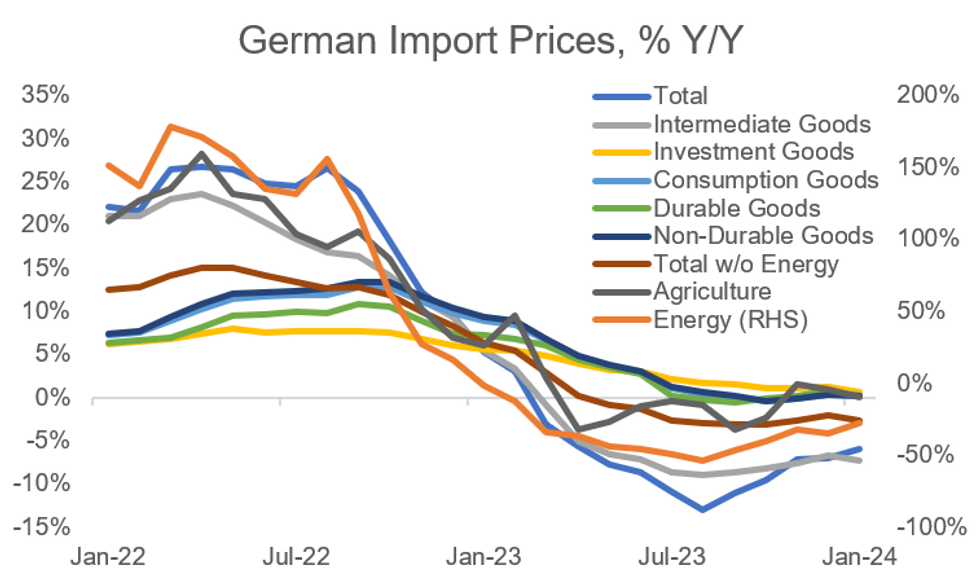-
Policy
Policy
Exclusive interviews with leading policymakers that convey the true policy message that impacts markets.
LATEST FROM POLICY: -
EM Policy
EM Policy
Exclusive interviews with leading policymakers that convey the true policy message that impacts markets.
LATEST FROM EM POLICY: -
G10 Markets
G10 Markets
Real-time insight on key fixed income and fx markets.
Launch MNI PodcastsFixed IncomeFI Markets AnalysisCentral Bank PreviewsFI PiFixed Income Technical AnalysisUS$ Credit Supply PipelineGilt Week AheadGlobal IssuanceEurozoneUKUSDeep DiveGlobal Issuance CalendarsEZ/UK Bond Auction CalendarEZ/UK T-bill Auction CalendarUS Treasury Auction CalendarPolitical RiskMNI Political Risk AnalysisMNI Political Risk - US Daily BriefMNI Political Risk - The week AheadElection Previews -
Emerging Markets
Emerging Markets
Real-time insight of emerging markets in CEMEA, Asia and LatAm region
-
Commodities
Commodities
Real-time insight of oil & gas markets
-
Credit
Credit
Real time insight of credit markets
-
Data
-
Global Macro
Global Macro
Actionable insight on monetary policy, balance sheet and inflation with focus on global issuance. Analysis on key political risk impacting the global markets.
Global MacroDM Central Bank PreviewsDM Central Bank ReviewsEM Central Bank PreviewsEM Central Bank ReviewsBalance Sheet AnalysisData AnalysisEurozone DataUK DataUS DataAPAC DataInflation InsightEmployment InsightGlobal IssuanceEurozoneUKUSDeep DiveGlobal Issuance Calendars EZ/UK Bond Auction Calendar EZ/UK T-bill Auction Calendar US Treasury Auction Calendar Chart Packs -
About Us
To read the full story
Sign up now for free trial access to this content.
Please enter your details below.
Why MNI
MNI is the leading provider
of intelligence and analysis on the Global Fixed Income, Foreign Exchange and Energy markets. We use an innovative combination of real-time analysis, deep fundamental research and journalism to provide unique and actionable insights for traders and investors. Our "All signal, no noise" approach drives an intelligence service that is succinct and timely, which is highly regarded by our time constrained client base.Our Head Office is in London with offices in Chicago, Washington and Beijing, as well as an on the ground presence in other major financial centres across the world.
Real-time Actionable Insight
Get the latest on Central Bank Policy and FX & FI Markets to help inform both your strategic and tactical decision-making.
Free AccessEx-Energy Import Price Deflation Continues
German January import prices came in above expectations at -5.9% Y/Y (vs -7.5% cons; -7.0% prior, revised from -8.5%) and 0.0% M/M (vs -0.4% cons; -1.0% prior, revised from -1.1%). On the yearly rate, this was the highest value since April 2023, and the fifth consecutive increase.
- Looking at the details of the release, energy price inflation remained the main downside driver overall but negative base effects are waning (-27.7% Y/Y vs -34.8% prior). Excluding energy, though, import prices actually decreased -2.5% Y/Y (vs -2.0% prior).
- Import prices primarily reflect goods and not services inflation dynamics, and are thus less important re ECB rate cut considerations as service inflation remains the main obstacle to potential cuts. Nonetheless, core German inflation should continue to be weighed down by subdued goods prices (NEIG prices have been relatively flat over the past 6-8 months).
- The import price data showed disinflationary trends in most categories. Intermediate goods import inflation broke a 4 month uptrend at -7.2% Y/Y (vs -6.7% prior), with the other main categories (investment goods, durables, non-durables, and agriculture) all coming in above zero but slower vs December on the yearly rate.
- Looking at the import prices' impact on economic activity, the fact that export prices decreased less quickly in the last months (-1.3% Y/Y Jan, -1.4% Dec) than import prices, should on balance be a positive positive development for German exporters. Producer prices have also continued to disinflate ex-energy in the past few months (latest data for February) - from this perspective, further goods consumer price disinflation might be in the pipeline.
 MNI, Destatis
MNI, Destatis
To read the full story
Sign up now for free trial access to this content.
Please enter your details below.
Why MNI
MNI is the leading provider
of intelligence and analysis on the Global Fixed Income, Foreign Exchange and Energy markets. We use an innovative combination of real-time analysis, deep fundamental research and journalism to provide unique and actionable insights for traders and investors. Our "All signal, no noise" approach drives an intelligence service that is succinct and timely, which is highly regarded by our time constrained client base.Our Head Office is in London with offices in Chicago, Washington and Beijing, as well as an on the ground presence in other major financial centres across the world.
